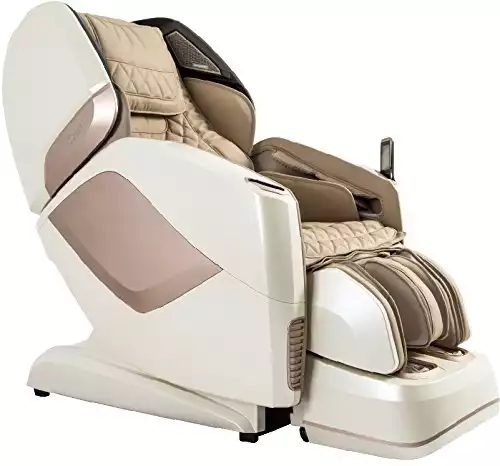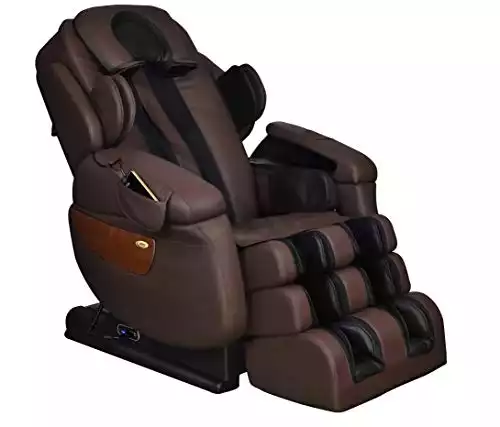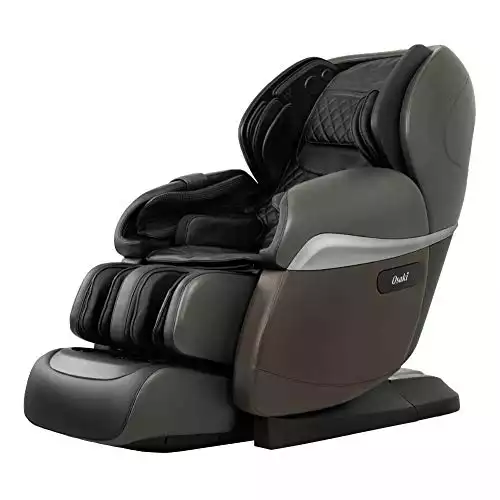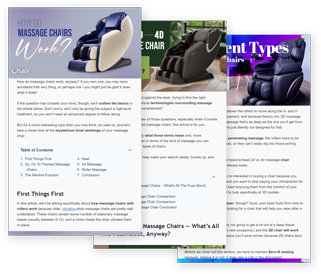In a Nutshell:
The Osaki OS Pro Maestro 4D Massage Chair has a very good mix of features, including a number of high-value therapeutic features. It does have one potentially crippling weakness. Recommended for anyone with deep pockets who doesn’t weigh more than 260 pounds.
Overall Massage Quality
Customization options
Ease of Use
Value for the Money
Brand Reliability*
Overall Rating
4.4/5
Benefits
Drawbacks
Recommended For: Anyone with deep pockets who don’t weigh more than 260 pounds.
Do you find yourself making regular trips to your friendly neighborhood chiropractor’s office in a bid to manage your chronic pain? Are you in the market for a massage chair that offers plenty of therapeutic features that can take the place of those visits?
If you answered yes to the questions above, then you’re going to be intrigued by what you read in this—our Osaki Maestro review.
On technical merits, this is a very good chair, but it is incredibly expensive, even among other Osaki recliners, and unfortunately, the high price alone is going to put it out of the reach of many. Worse, this chair has a couple of limitations that may make it a less-than-ideal choice for you.
Don’t get us wrong. This is an unquestionably solid design that gets a lot right, but we would be doing our readers a disservice if we weren’t unflinchingly honest about this model’s shortcomings too.
That’s what you’ll find here. In the sections that follow, we’ll step you through everything this chair has to offer and give you the straight scoop about its limitations. That way, you’ll have all the information you need, right at your fingertips, to decide whether or not this is the model you’ve been looking for. If that sounds good to you, read on, and let’s take a closer look!
An Overview Of The Osaki OS Pro Maestro 4D Massage Chair
The very first thing we should mention about this model is that there are actually two variants: the Pro Maestro 4D and the slightly more expensive Pro Maestro 4D LE. The two models are broadly similar, but where there are differences, we’ll highlight the “extra” features that the Limited Edition (LE) model brings to the table.
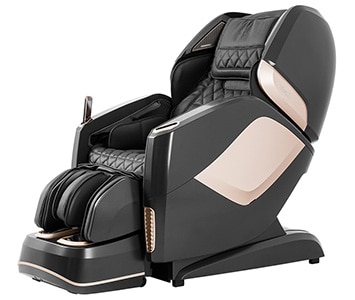
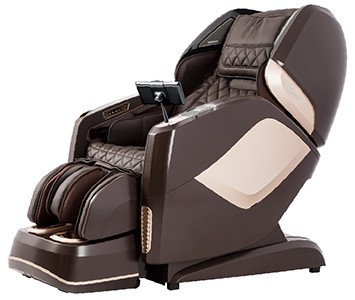
With that detail attended to, the next thing we should say is that although first impressions aren’t everything, they do matter, and aesthetics are at least somewhat important.
Massage chairs aren’t known for their grace and beauty, and this chair is designed along purely conventional lines, which is to say that the design team behind the Maestro didn’t take any chances.
This chair looks a lot like most of the other massage chairs on the market today. It’s got a funky, vaguely futuristic look that makes it stand out when placed next to regular furniture.
If your home is decorated with a sci-fi theme, the Maestro will probably fit right in. If not, it’s going to stick out, but that’s not the worst thing. After all, most people buy a massage chair with performance in mind, and if that’s where you are, then you’re almost certainly not going to care that it doesn’t blend seamlessly with the rest of your living room furniture.
On the other hand, if aesthetics really matter to you, you should know that you can find massage chairs that do blend in seamlessly with conventional furniture, at least during the times you’re not actually getting a massage.
If that’s what you’re interested in, then right off the bat, we can say that this chair isn’t for you. While there are several companies that make chairs like that, nobody does it better than Human Touch, and that’s probably where you’d want to start.
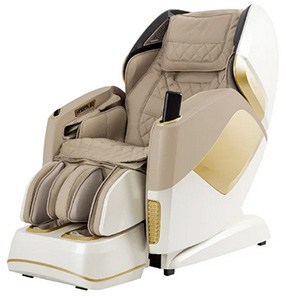
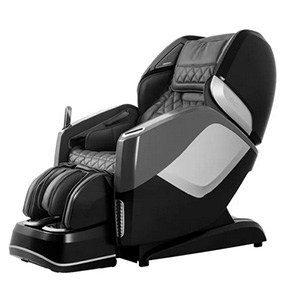
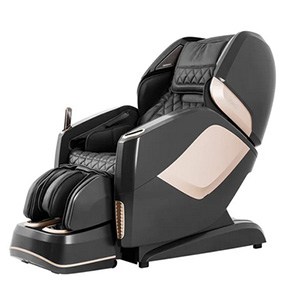
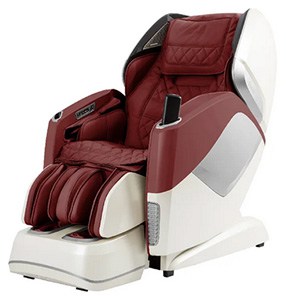
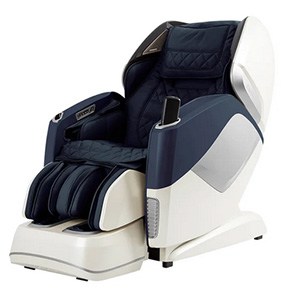
Assuming you’re fine with the look of the chair, and you decide you want one of these, if you get the “standard” Maestro, you’ll be able to order yours in any of the following colors:
Interestingly, if you get the more expensive LE model, your color options are more restricted, being limited to:
We would have thought the color selection would have been reversed and that the more expensive model would offer more on this front, so this detail took us by surprise.
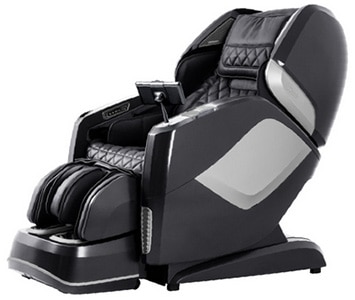
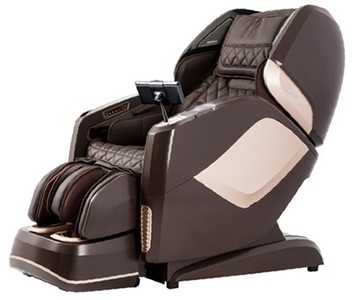
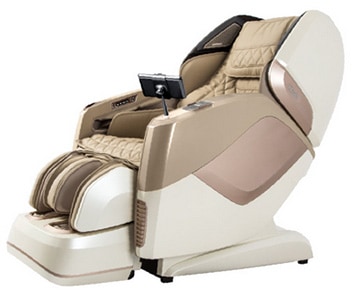
Moving beyond simple aesthetics, we should also point out that this is a big, burly piece of furniture, with a footprint that measures 61.1” L (79.5” L when fully reclined) x 31.9” W x 48.1” H (46.9” H when fully reclined), and weighing in at a respectable 244.6 pounds.
If you live in a smaller home or apartment, you may struggle to find a permanent home for the chair, but there are a couple of silver linings here.
First, the Osaki Maestro chair is designed with wall-hugging technology, so it only needs about 5” of clearance between the back of the seat and whatever wall you place the chair near in order to fully recline.
Second, it’s worth mentioning that if you’re willing to pay an extra fee, White Glove delivery service is available. If you choose to go this route, all you’ll have to do is tell the delivery guys where you want it, then sit down and enjoy your first massage when they’re done.
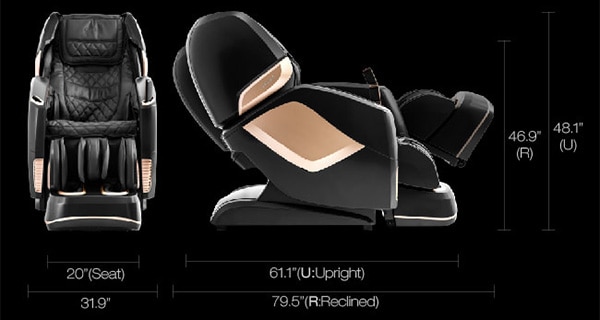
If you opt to set it up yourself, there will be a nominal amount of assembly work required, and you’ll almost certainly want to have a trusty assistant at the ready on the day the chair arrives at your door, if for no other reason than to help wrestle it into position in whatever room it’s destined for.
There is one final thing we need to draw your attention to before we leave this section, and it is, in our view, a glaring weakness in the chair’s design.
Despite its size and heft, this chair is only capable of supporting 260 pounds. That’s disappointing and then some because most of the massage chairs on the market support 300 pounds, with some models capable of supporting significantly more than that.
This limitation holds true for both the standard and the LE models and really limits the appeal of the model. Unfortunately, this is a serious enough design weakness that it could be an outright dealbreaker.
Osaki Pro Maestro 4D Massage Chair Boasts Cutting-Edge Massage Chair Technology
We’d rate this as a very strong component of our Osaki Maestro review. Osaki does a great job covering the basics and implementing the core technologies we’ll talk about here.
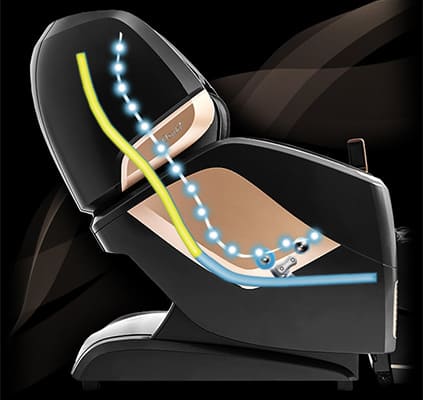
This chair sports a wonderfully long SL track that supports the 4D quad rollers that ride upon it. The length of the track allows the rollers to move along the X-, Y-, and Z-axis. That total freedom of movement is one of the big reasons that the roller action so closely mimics the feel of human hands.
In addition to that, note that we described this as a 4D massage chair. If you’re not sure what that means, here’s a quick overview:
Older massage chairs only allow the rollers to move in two dimensions: along the X- or Y-axis. They are unable to move “in” and “out,” so they’re not capable of giving a true deep tissue massage.
A 3D massage chair has a track designed such that the rollers can move along the Z-axis too, which does make them capable of rendering a deep tissue massage.
The 4D chair allows that too, but in addition to that, it varies the speed and intensity of the rollers dynamically, based on where the rollers are touching your body. This is a key difference that helps the rollers of 4D massage chairs render a massage that’s even closer to the feel of human hands, and it is amazing.
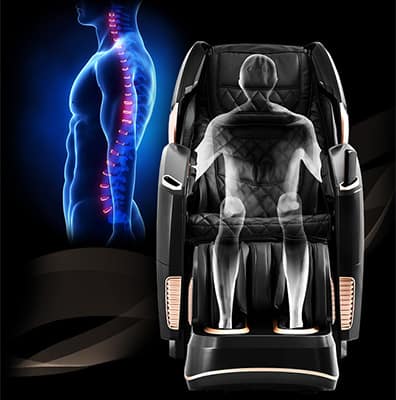
Since the Osaki Maestro Pro has both an SL track and leg massage ports, it is capable of rendering something that is effectively a full body massage, with the rollers starting at your neck and shoulders and traveling to the backs of your thighs, then the airbags and rollers in the leg massage ports taking over from there. That’s just marvelous.
In addition to the long massage track and leg massage ports, the Maestro utilizes Osaki’s excellent body scanning technology, which takes a quick scan of your body each time you order a massage. Based on the results of the scan, the chair quietly adjusts the position of the rollers so that they perfectly align with your pressure points.
In practice, the tech gets the rollers in the right place about 95% of the time, and on those odd occasions where something’s a little off, you’ll find manual controls on the included remote that will allow you to tweak the position of the rollers until they’re just where you want them.
This provides an unbeatable one-two punch that makes it virtually impossible to get anything less than a world-class massage from this chair.
That brings us to the topic of the remote, which is exceptionally well designed and boasts a larger LCD screen than you’ll find on most of the other massage chairs on the market today.
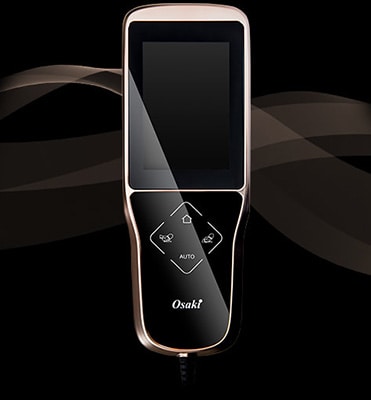
It’s worth mentioning, too, that if you decide to upgrade to the LE variant of this chair, you’ll get a 7” LCD flat panel screen in place of the standard remote.
This is a small thing, but honestly, it’s a significant upgrade that makes using the chair a great deal easier. In fact, once you’ve used the touchscreen, you won’t ever want to go back! Everything else will seem cramped.
In addition to the remote, you’ll find a convenient secondary control system located on the inside of one of the chair arms. While the controls here won’t allow you to manage every aspect of the chair, they will make the basic controls available to you, which is awesome.
The final thing to mention here is that Osaki makes an app for both Android and iOS devices that can be used to control the chair, which gives you a third possible control system—you can control every aspect of the chair right from your phone!
Osaki Maestro Massage Chair Offers A Disappointing Number Of Massage Options
To be completely honest, we find this to be a disappointing component of our Osaki Maestro review. This is a top-end chair with a top-end price, and the technologies we describe in this section represent the main purpose of a massage chair.
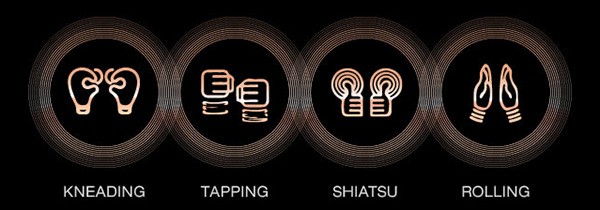
People don’t buy massage chairs for looks; they buy them so they can get a great massage and feel better, so this section is pretty important. And in our view, Osaki kind of phoned it in here. It’s easy—really, stupendously easy—to find comparably priced or cheaper chairs that offer more in this category than this one does, and that’s a shame.
Let’s take a closer look at what’s here.
Starting with massage techniques, we find four:
That’s not a lot. You can, in fact, find entry-level chairs that cost about 20% of what this one will set you back that offer more in the way of techniques, and you can pretty easily find massage chairs that offer multiple advanced massage techniques to boot, so…yeah. We’re not all that impressed.
Having said that, it’s also true that this chair offers four different “characteristics” of each of these techniques, and if you’re being super generous and count each of those as a separate technique, that will technically give you a total of 20 variations, but here’s the thing:
Not even Osaki counts them as techniques. At best, they are minor variations on a theme, so…no. It’s cool that they’ve offered something beyond just the four basic techniques, but for the money, that’s just not enough in our book.
Okay, but the company still has a chance to redeem itself. What if they offered a ton of cool auto-programs? That would make up for the relative lack of techniques, wouldn’t it?
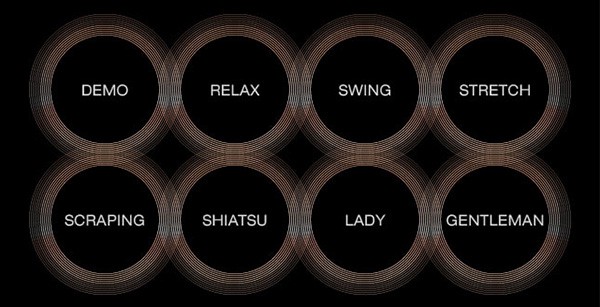
Yes, it probably would, except that the company didn’t do that either. On the standard model, you’ll find the following pre-programmed options:
These are fine. Well, for the most part, these are fine. Demo is just that—a short massage session that quickly runs you through the four different techniques the chair offers, so we’re not sure if that should be counted as a “proper” pre-programmed routine, but whatever.
Even if we give the company the benefit of the doubt here, the standard model only comes with eight options, and that’s weak.
Even worse, one of the pre-programmed options is Shiatsu, which you can get simply by going into manual mode and selecting that technique, so it’s really not a “proper” pre-programmed massage option either.
Granted, other than those two, the rest are quite good, but that leaves us with just six.
Of the remaining six, the Stretch routine is the very best of the bunch, and it is amazing. Not only does it feel great, but it’s also got a ton of therapeutic value as it closely replicates the “adjustment” you get when you go to your local chiropractor’s office, so that’s very good indeed.
On top of that, this chair really does offer a lot in terms of manual controls. You’ll find eight different 4D intensity level controls, five speed controls, and five intensity controls for non-4D mode.
That, combined with the massage techniques on offer, and further combined with spot and partial modes, plus body zone control (neck & shoulder, upper back, lower back, and full back offered on the remote), gives you an impressive number of customization options for building your own perfect massage.
We love that, but we don’t feel that it’s enough to make up for the disappointing number of massage techniques and pre-programmed options. It’s good, but it’s not that good, especially given that there are no memory slots that would allow you to save your custom creations.
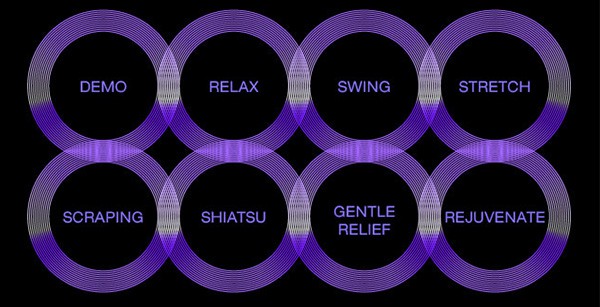
Before we leave this section, it’s worth pointing out that if you spend extra to get the Osaki OS Pro Maestro LE 4D massage chair, while the massage techniques on offer won’t change, the pre-programmed options do, and on the LE variant, they are:
This is better than what you find on the standard model, but again, there is some redundancy here. We’re not sure that “Demo” should be counted as a pre-programmed option because aside from first use to get acquainted with the chair, it’s not something you’ll often use (if ever), and Shiatsu is accessible as a manual massage option anyway.
Again though, Stretch is the headline option, and it has incredible therapeutic value.
Overall, we’d rate the chair for this component as being strictly average and perhaps even slightly below average. While the chair offers an impressive number of customization options for manual mode, it doesn’t offer any way to save your manual massage creations, which works against that aspect of the design.
In addition to that, there are depressingly few massage techniques and pre-programmed massage options on offer, and these things are really the heart and soul of what a massage chair is for, so we feel Osaki missed an opportunity by not offering more here, especially on such an expensive chair.
The Osaki 4D Pro Maestro LE model is better, but in our view, it still falls short.
Osaki Maestro 4D Massage Chair Offers Heat Everywhere!
If the last segment was a little underwhelming, this one does a lot to make up for it, and overall, we’d rate this as being the strongest single component of our Osaki Pro Maestro review.
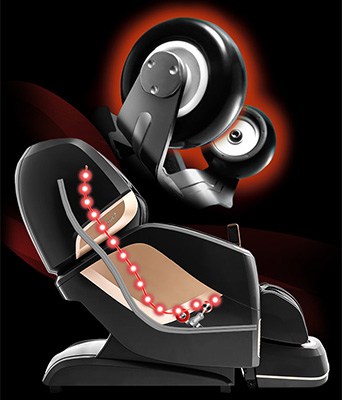
We’ve already talked about or at least hinted at two therapeutic features this model brings to the table, with the first being deep tissue massage and the second being the company’s excellent body stretch.
The presence of heat makes a third high-value therapeutic feature, and here, the heat is especially well implemented because it’s everywhere. Well, not quite, but the rollers themselves are heated, so anywhere they go, you get heat.
The massage you get from this chair is already fantastic, but when you add heat to the equation, it just moves things to a whole new level, and this feature makes the chair magnificent.
We love it, and if you decide to get one of these, either this or the calf and foot massage—which we’ll talk about in just a bit—will wind up being your favorite aspect of the design.
Osaki 4D Pro Maestro Has A Decent Air Massage But…
Equipped with a grand total of 32 airbags, we found this to be a little underwhelming, honestly. You can find entry-level massage chairs that sport nearly as many, and in some cases, even more airbags. And generally speaking, the more airbags you use to render an airbag-based massage, the better, so this is another feature where it feels like Osaki just phoned it in.

That’s not to say it’s a bad feature—it isn’t! The airbags are expertly placed, and the chair makes very good use of the 32 airbags it has to work with. Even better, you can customize your experience via the remote, selecting from five different intensity settings.
Or if you don’t want the full air experience, you can choose to activate airbags in certain body regions, selecting from the following:
Our sense of it, though, is that the airbags mostly exist to accommodate the stretch function, and the fact that you can also get a pretty good air massage is considered a bonus. We can’t imagine that anyone would buy this chair based solely on the strength of the air massage. It’s just not that good, honestly.
Zero-G Included
We really, really wanted to like this feature, but again, we’re a bit underwhelmed here. Yes, it is true that the Maestro massage chair offers a Zero-G seating position, and that is fantastic!
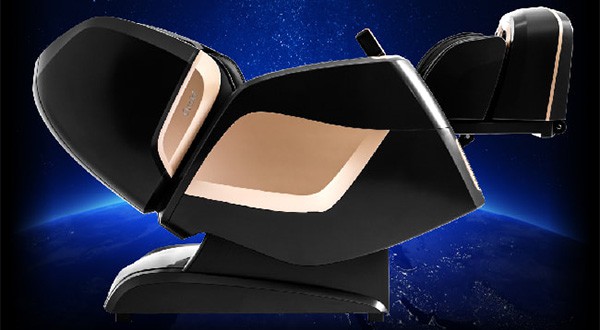
Zero-G is yet another therapeutic feature that really adds value to the design.
Inspired by NASA, it works by placing your feet such that they’re elevated slightly above your heart and has been shown to provide a raft of benefits, including helping to lower your blood pressure, improve your circulation generally, and even facilitate faster post-surgical healing, so it’s a very strong feature.
Here’s the rub: this is a super expensive chair. You can find entry-level chairs that cost a fraction of the price of this one that offer Zero-G seating. In fact, it’s easy to find massage chairs that cost much less money that offer two or even three different Zero-G seating positions.
The bottom line is, with only a single Zero-G seating position available, nobody is ever going to buy this chair on the strength of that feature. It’s nice, but again, it feels as though Osaki under-delivered here.
Osaki OS4D Pro Maestro Offers A Spectacular Calf and Foot Massage
Honestly, this is our favorite aspect of the design of the Osaki 4D Maestro. It’s an almost perfect feature implementation.
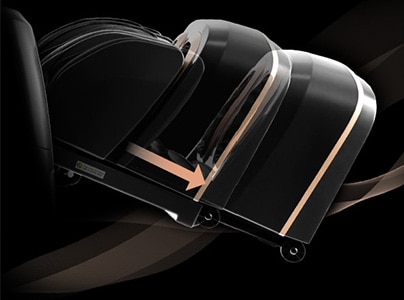
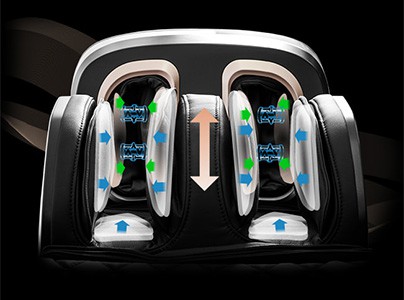
Most calf and foot massages are rendered like this: airbags for your calves and rollers for the soles of your feet. Osaki does much more than that here.
You get airbags for your calves, but in addition to the usual compression, the airbags in this section also rotate in a circular motion, giving you a whole new dimension to the calf massage that you just won’t find on any other chair (at least not so far!).
Then for your feet, you get a mix of airbags and foot rollers, but Osaki goes a bit further here as well, adding a stretch massage to your feet, which is really relaxing.
Honestly, the only way that this could be made better would be if the company added heat to the footwells on some future model upgrade.
Even without that, though, this is the keystone feature of the design. If you suffer from chronic pain in your calves and/or feet, this is going to be hands down your favorite feature of the chair. We wouldn’t go so far as to say that the Osaki Pro Maestro is worth the asking price on the strength of this feature alone, but it’s amazingly well done, and we think you’ll love it.
Osaki Pro Maestro Massage Chair Has A Few Extras, Too
We feel that Osaki skimped a bit here, but we can’t really hold it against them, even given the price of the chair. Extras are just that—extra. They’re nice to have, but nobody’s going to lose much sleep if they’re absent.
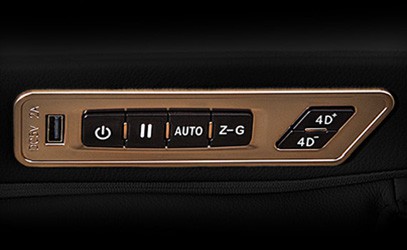
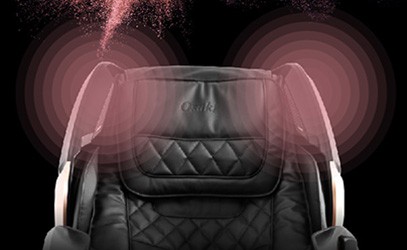
The big extras to talk about here are the LED accent lights, the USB port built into the chair, and the Bluetooth speakers. It’s very nice to be able to keep your phone charged and listen to your favorite music, watch a movie, or listen to podcasts and the like while getting a massage.
The Maestro also offers a basic, no-frills massage timer. The default time for all massages this chair offers is fifteen minutes, and you can increase or decrease the duration in five-minute increments to a minimum of five minutes and an absolute maximum of thirty minutes.
This is pretty standard fare, and you find that configuration on a great many of the massage chairs on the market today.
One thing we were disappointed with here is the fact that the Maestro doesn’t offer any memory slots. The chair gives you all sorts of ways to customize and personalize your massage in manual mode, but it doesn’t give you a way to save your creations, so every time you want “that awesome massage you made,” you’ll have to re-create it, which is annoying.
Not the end of the world, but annoying.
It’s also worth bringing up again the fact that the Osaki Maestro LE massage chair offers a couple of fun upgrades and extras that the standard variant lacks, including the wireless charging pad and the nice 7” LCD touch screen that takes the place of the standard remote. Those are superb additions that really add some extra value to the equation.
Pros & Cons of Osaki OS Pro Maestro 4D Massage Chair
This chair gets a lot of things right. It offers a staggering array of customization options that allow a user to drill down and create exactly the massage experience they want. It also boasts heat everywhere (heated rollers!) and is one of the best calf and foot massages in the industry.
Those are unquestionably good things and all valid reasons for considering buying this model over some other.
Unfortunately, there are a fair number of features that Osaki basically phoned in where this chair is concerned. It only has one Zero-G seating position. It doesn’t offer a lot in the way of massage techniques, and it doesn’t give you much in terms of pre-programmed massage options, either.
Ultimately, it comes down to how important those things are to you.
Osaki Maestro Review Conclusion
We like this chair, but we don’t love it. At the price point the Maestro is competing at, we were expecting more. A chair offered at this level has to get everything right because that’s the standard set by most of its competitors.
That said, if your main purpose in getting a massage chair is to buy from a respected company and your main complaints are that you want to replace trips to your local chiropractor to get adjusted, and you’re looking for something that can give you a fantastic massage and help mitigate the pain in your legs, this chair belongs on your shortlist of options to consider—despite its other limitations.
In our view, that probably only describes a fairly narrow segment of the market, made even narrower by virtue of the fact that this chair only supports up to 260 pounds of user weight, but for people who check all those boxes, this is an amazing chair. On that basis, we provisionally recommend it.
Other Options To Consider
If you’ve reached the end of this review and you’re not completely sold on the model we just talked about, here are a couple of other options you may want to consider.
Recommended For: Anyone who can afford it. Exceptional therapeutic chair, made in the USA, packed with high-value features.
This is an older model, but it’s still, to this day, one of the best therapeutic massage chairs on the market. If you’re looking for a massage chair that offers tons of therapeutic value, save some money and get this one. It punches well above its weight class in terms of therapeutic benefit.
Recommended For: Anyone weighing up to 280 pounds, especially if you can find this model on sale (which is fairly often!). The sale price approaches a 50% discount, making the Paragon an insanely good value.
Honestly, we’d rate this as being a better chair—pound for pound—than the Maestro, and it’s cheaper, too. Even better, Osaki often offers this one at deeply discounted prices, so you can pick it up for a song if you’re willing to wait for a sale. And if you get it on sale, it offers one of the best value propositions in the massage chair market today. A spectacular design.
REFERENCES AND RESOURCES
- Osaki, Official Brand Website.
- Osaki OS Pro Maestro 4D Massage Chair User Manual.
- 8+ Science-Based Benefits of Massage, Self Decode.
- Types And Benefits Of Back Massage, Organic Facts.
- Post Injury: When Can Massage Help, Physio.co.uk.
